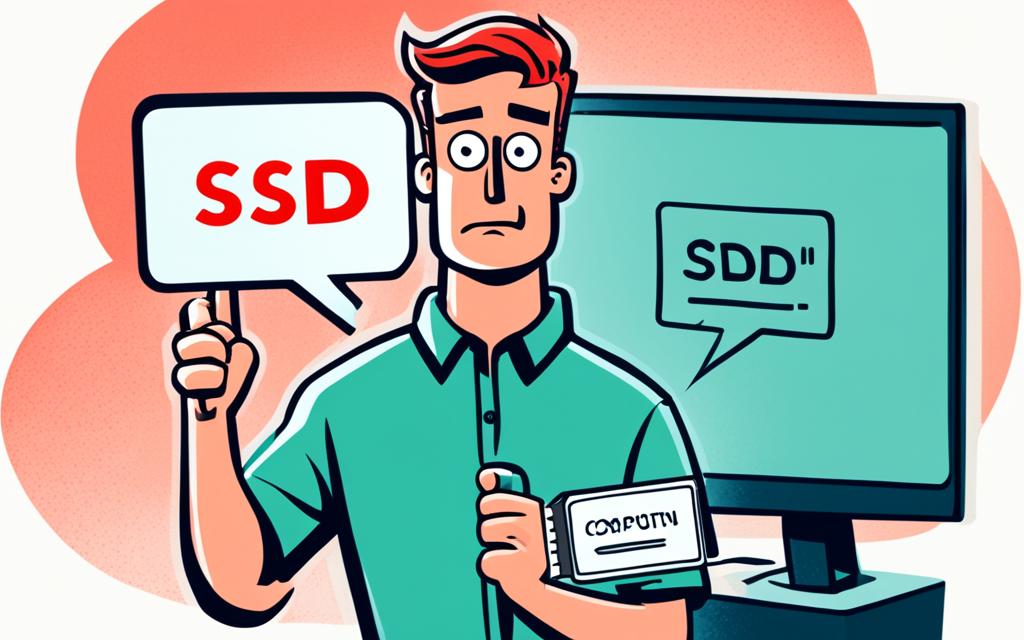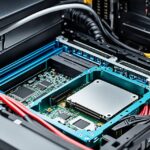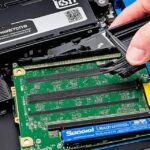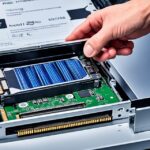Table of Contents
Moving to a new PC is exciting, especially if you want to keep your setup the same. You can move your SSD to not only keep your apps and settings but also get quicker data access speeds than old HDDs1. This guide will help you understand how to make your SSD work with your new computer. We’ll cover how to move your Windows installation to improve how your PC works1. You’ll learn the steps to take, the tools that can help, and the issues you might face, making switching to new tech easy.
Key Takeaways
- Moving an SSD makes upgrading your computer simpler, without reinstalling everything.
- It’s important to back up your data before moving your OS to an SSD.
- A lot of people use their old SSD as the main drive in a new PC2.
- Third-party tools can make moving your SSD to a new PC smoother.
- Often, you need to format your SSD before putting it in a new computer2.
- After moving your SSD, you can usually reactivate Windows with your Microsoft account2.
Understanding SSD Compatibility with New Hardware
Before adding an SSD to new hardware, knowing which SSD types fit is essential. SATA and NVMe SSDs might not work if the new system only supports certain ones. By 2023, SSDs have become key for storing data in most computers, taking over from old HDDs3. It’s important to make sure the SSD matches the new computer’s motherboard.
The operating system on the SSD needs certain drivers to work well with both the old and new systems. Confirming both computers have similar parts helps make the SSD switch smoother. If they don’t match, you might have to reinstall the operating system or make other changes for it to work.
SSDs boost your computer in many ways, like faster start-ups and loading times. They are also more durable, use less power, and don’t get as hot as HDDs4. With SSDs fitting into more devices, upgrading with an SSD is becoming more common.
| SSD Type | Interface | Speed (Read/Write) | Common Use Cases |
|---|---|---|---|
| SATA SSD | SATA III | Up to 600 MB/s | Basic upgrades, laptops |
| NVMe SSD | PCIe | Up to 3,500 MB/s | High-performance tasks, gaming |
| M.2 SSD | M.2 PCIe/SATA | Varies greatly | Compact designs, gaming laptops |
Switching to an SSD can make your computer up to ten times faster than using an HDD2. This upgrade significantly enhances how you experience using your computer.
The Process of Moving an SSD: Basic Steps
Embarking on the SSD migration process involves essential steps to ensure a smooth transition. Start by making a thorough backup of your data. This step makes sure no valuable information gets lost during the move.
Then, check the compatibility of your new PC with your SSD. It’s vital to make sure the right hardware drivers are available. Though Windows 10 has gotten better at handling driver issues, there might still be problems. Moving an SSD between AMD, Intel, or Nvidia systems usually goes smoothly. Yet, each PC might present its own set of challenges during the migration5.
Before you install the SSD, get your new system ready. It should have a solid power source and the correct connections. Be sure to follow the manufacturer’s instructions when moving the SSD to ensure it fits well in the new setup.
Once the SSD is in the new machine, turn it on. Accessing the BIOS to change the boot order might be necessary. This step ensures your system recognises the SSD. Windows might notice the hardware change and deactivate for some license types. Using a tool like DDU helps remove old drivers5. EaseUS Disk Copy is a good tool for transferring Windows to a new SSD. It lets you move your OS without losing data or needing to reinstall.
| SSD Migration Steps | Description |
|---|---|
| Backup Data | Save all crucial files to prevent loss during the SSD migration process. |
| Check Compatibility | Make sure the new PC can work with the SSD and has the right drivers. |
| Prepare the New System | Get the new computer ready for the SSD with enough power supply. |
| Install the SSD | Following the guidelines, remove and securely install the SSD into the new system. |
| Boot and Configure | Start the new machine, tweak BIOS settings, and ensure it recognises the SSD. |
Can You Move an SSD to a New PC?
Transferring an SSD to a new PC requires looking at both machines’ hardware setup. If both PCs have hardware similarity, moving the SSD is likely straight forward. Installing the SSD in the new computer might let the Windows installation work without extra steps. This method is great because the operating system can often update itself with the right drivers. It allows users to transfer their SSD easily as discussed at move SSD, avoiding unnecessary hassle.
Discussion on Hardware Similarity
If both computers have similar parts, switching SSDs becomes easier. This change means quicker access and better performance, thanks to the SSD’s speed. Especially, NVMe SSDs bring a new level of quickness in accessing data. The similarity in parts helps make swapping straightforward. It also means you won’t lose any data or have to reinstall programs.
Explaining Hardware Dissimilarity Challenges
However, differences in hardware can introduce problems. When you move an SSD to a different setup, issues like driver mismatches may happen. Correcting these issues might mean having to reinstall Windows. Deciding between cloning the SSD or doing a fresh install is essential here. Consider the effects of both choices carefully671. Think about potential problems such as losing data or apps not working. Making a backup and planning the type of install can help avoid these issues.
Preparing Your Old and New Systems
Getting ready for SSD migration is key for a smooth change to a new computer. Start with a full backup of your important files. This backup shields you from losing data during the swap. It’s wise to update the old system’s operating system fully. This step decreases the chance of facing issues when shifting to the new setup. Also, make sure you can get to all the drivers your new device’s hardware needs. This is especially true for vital parts like graphics and network cards8.
Check that the new SSD can hold all data from the old drive before starting. A reliable power source is vital to avoid any hiccups during the transfer. Even short power cuts can lead to big problems. Using a step-by-step method, such as the one in AOMEI Partition Assistant Professional, helps clone your SSD well. This tool also shows how versatile it is for different situations25.
Understanding the specs of both your old and new systems is crucial whether you’re cloning or starting fresh. This knowledge allows you to tackle any hardware differences head-on. This makes your SSD switch safer and more successful. Remember, careful preparation is the secret. It saves you both time and effort later85.
FAQ
What should I do before moving my SSD to a new PC?
First, it’s vital to back up your data. Make sure your operating system is up-to-date. Check that all necessary drivers are available and compatible with your new hardware.
How do I check if my SSD is compatible with the new PC?
Check compatibility by confirming the SSD type (like SATA or NVMe). Ensure your new PC’s hardware drivers are compatible with your operating system.
Are there any risks involved in transferring my SSD?
Yes, risk exists, especially with hardware differences that may cause driver issues. It’s wise to prepare and possibly do a new Windows install if needed.
Will my applications and preferences transfer successfully when I move my SSD?
If the hardware is similar, applications and settings usually transfer well. Yet, different hardware might need more adjustments. Be ready for any complications.
What steps should I follow for a seamless SSD migration?
To migrate smoothly, firstly back up your data. Check both systems for compatibility. Prepare your new PC. Then, install the SSD. Finally, set up the BIOS so it recognises the SSD during boot-up.
Is it better to clone my old SSD or perform a fresh installation on the new PC?
It hinges on the hardware’s similarity. Cloning works well for similar systems. However, a fresh Windows install might be smarter for significantly different hardware.
Source Links
- https://www.acronis.com/en-gb/blog/posts/how-to-move-os-to-another-drive/ – How To Move OS To Another Drive – Complete Guide & Software
- https://www.diskpart.com/articles/old-ssd-with-windows-on-new-pc-1503.html – Can I Use My Old SSD with Windows on New PC?[Explained]
- https://www.backblaze.com/blog/ssd-upgrade-guide/ – How to Upgrade Your Computer: Migrating from HDD to SDD
- https://www.crucial.com/articles/about-ssd/how-to-upgrade-to-an-ssd – How to Upgrade to an SSD
- https://www.pcmag.com/how-to/move-your-windows-drive-to-a-new-pc – Good Migrations: How to Move Your Windows Drive to a New PC
- https://www.kingston.com/en/blog/personal-storage/use-your-old-ssd-as-external-storage – How to Use Your Old SSD as an External Storage Drive
- https://www.ubackup.com/clone/how-to-move-files-from-one-ssd-to-another-6688.html – How to Transfer Data/Files from One SSD to Another [2 Ways]
- https://www.diskpart.com/articles/how-to-transfer-windows-10-ssd-to-a-new-pc-1503.html – How to Transfer Windows 10 SSD to a New PC?








